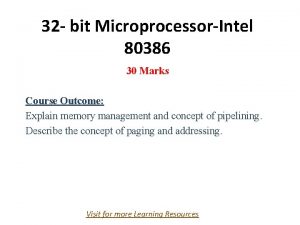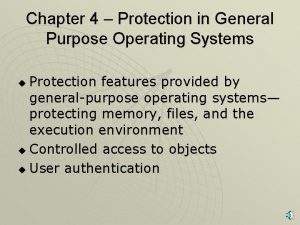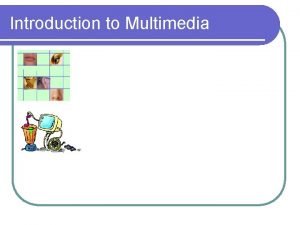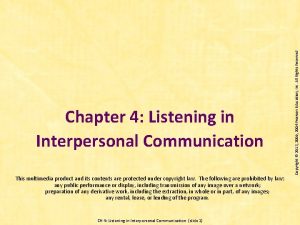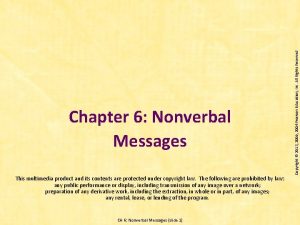This multimedia product and its contents are protected












- Slides: 12

This multimedia product and its contents are protected under copyright law. The following are prohibited by law: any public performance or display, including transmission of any image over a network; preparation of any derivative work, including the extraction, in whole or in part, of any images; any rental, lease, or lending of the program. CH 1: Foundations of Interpersonal Communication (slide 1) Copyright © 2013, 2009, 2006 Pearson Education, Inc. All Rights Reserved Chapter 1: Foundations of Interpersonal Communication

§ Personal success § Social success § Professional success CH 1: Foundations of Interpersonal Communication (slide 2) Copyright © 2013, 2009, 2006 Pearson Education, Inc. All Rights Reserved Why Study Interpersonal Communication (IPC)

1. Interdependent individuals § Connected § Actions of one impacts the other 2. Inherently relational § Defines the relationship § Varies depending on the relationship CH 1: Foundations of Interpersonal Communication (slide 3) Copyright © 2013, 2009, 2006 Pearson Education, Inc. All Rights Reserved The Nature of IPC

3. Exists on a continuum Impersonal Interpersonal § Social role information § Social rules § Social messages § Personal information § Personal rules § Personal messages CH 1: Foundations of Interpersonal Communication (slide 4) Copyright © 2013, 2009, 2006 Pearson Education, Inc. All Rights Reserved The Nature of IPC (cont. )

4. Involves verbal and nonverbal messages 5. Takes place in varied forms § Face to face § Computer mediated § Synchronous – occur simultaneously, in “real time” § Asynchronous – do not occur in “real time” 6. Involves choices (choice points) CH 1: Foundations of Interpersonal Communication (slide 5) Copyright © 2013, 2009, 2006 Pearson Education, Inc. All Rights Reserved The Nature of IPC (cont. )

1. Source – receiver 2. Encoding – decoding 3. Messages § Metamessages § Feedforward § Feedback 4. Channels CH 1: Foundations of Interpersonal Communication (slide 6) Copyright © 2013, 2009, 2006 Pearson Education, Inc. All Rights Reserved Elements of IPC

Copyright © 2013, 2009, 2006 Pearson Education, Inc. All Rights Reserved Elements of IPC (cont. ) 5. Noise § § Physical Physiological Psychological Semantic CH 1: Foundations of Interpersonal Communication (slide 7)

6. Context § § Physical Temporal Social-psychological Cultural 7. Ethics CH 1: Foundations of Interpersonal Communication (slide 8) Copyright © 2013, 2009, 2006 Pearson Education, Inc. All Rights Reserved Elements of IPC (cont. )

CH 1: Foundations of Interpersonal Communication (slide 9) Copyright © 2013, 2009, 2006 Pearson Education, Inc. All Rights Reserved

1. IPC is a transactional process § An ever-changing, circular process § Interdependent elements; each element affects the other 2. IPC is purposeful 3. IPC is ambiguous CH 1: Foundations of Interpersonal Communication (slide 10) Copyright © 2013, 2009, 2006 Pearson Education, Inc. All Rights Reserved Principles of IPC

4. IP relationships may be symmetrical or complementary § Symmetrical – individuals mirror each other’s behaviors § Complementary – individuals engage in different or opposite behaviors CH 1: Foundations of Interpersonal Communication (slide 11) Copyright © 2013, 2009, 2006 Pearson Education, Inc. All Rights Reserved Principles of IPC (cont. )

5. IPC refers to content and relationship 6. IPC is a series of punctuated events § We break down continuous interactions § No clear cut beginning or ending § What is stimulus and what is response? 7. IPC is inevitable, irreversible, unrepeatable CH 1: Foundations of Interpersonal Communication (slide 12) Copyright © 2013, 2009, 2006 Pearson Education, Inc. All Rights Reserved Principles of IPC (cont. )
 Mikael ferm
Mikael ferm Linear multimedia definition
Linear multimedia definition Multimedia becomes interactive multimedia when
Multimedia becomes interactive multimedia when Multimedia becomes interactive multimedia when
Multimedia becomes interactive multimedia when Esa multimedia.esa.int./multimedia/virtual-tour-iss
Esa multimedia.esa.int./multimedia/virtual-tour-iss Real protected and virtual modes of 80386
Real protected and virtual modes of 80386 The kidneys are protected by the ribs and a cushion of fat
The kidneys are protected by the ribs and a cushion of fat Protected objects and methods of protection
Protected objects and methods of protection The emigree analysis
The emigree analysis Its halloween its halloween the moon is full and bright
Its halloween its halloween the moon is full and bright Multimedia products definition
Multimedia products definition Multimedia product
Multimedia product R087 client brief
R087 client brief





